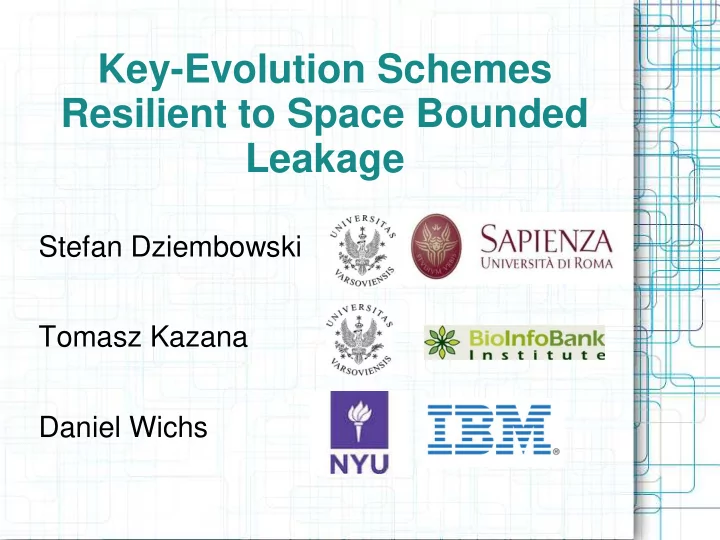

Key-Evolution Schemes Resilient to Space Bounded Leakage Stefan Dziembowski Tomasz Kazana Daniel Wichs
Main contribution We propose a secure scheme for deterministic key-evolution Properties: leakage-resilient in the random oracle model
Outline 1. Key-Evolution Schemes Resilient to Space Bounded Leakage 2. Key-Evolution Schemes Resilient to Space Bounded Leakage 3. Previous results in the area 4. The model 5. Random Oracle Model – remarks 6. Result and proof techniques
Key-Evolution Schemes Resilient to Space Bounded Leakage cryptographic device CRYPTO
Key-Evolution Schemes Resilient to Space Bounded Leakage Side channel information: power consumption, electromagnetic leaks, timing information, etc. cryptographic device
Key-Evolution Schemes Resilient to Space Bounded Leakage (standard) black-box access cryptographic scheme additional access to the internal data
Key-Evolution Schemes Resilient to Space Bounded Leakage Generally speaking we model: Side-channel leakage Leakage caused by malicious software (viruses etc.)
Key-Evolution Schemes Resilient to Space Bounded Leakage In each round the secret key K gets refreshed . K 0 Assumptions: key evolution function f has to K 1 = f(K 0 ) be deterministic K i+1 = f(K i ) K 2 = f(K 1 ) (no refreshing with external randomness) K 3 = f(K 2 ) also the refreshing procedure may cause leakage K 4 = f(K 3 ) New leakage in every round
Previous work on leakage- resilient key-evolution Kocher: Leakage function cannot make any random oracle calls Output length is bounded slightly smaller then |k|
Previous work on leakage- resilient key-evolution Yu Yu et al.: Leakage not adaptive Leakage function cannot evaluate hash function (modeled as usual by random oracle model)
Previous work on leakage- resilient key-evolution Dziembowski and Pietrzak : “only computation leaks information” model, so data can leak if and and only if it is accessed
Our approach middle-of-the-road approach Most prior “practical” papers Simple and efficient Intuitive notion of security without formal guarantees Most prior “theoretical” papers Rigor and provable security Strong restrictions , eg. Only data actually used in computation can leak
Modelling the leakage “Memory attacks”, “Bounded - Retrieval Model”: The adversary is allowed to learn any input-shrinking function f of the secret: f K f(K)
Problem The function f can compute the “future keys”: compute K 100 and leak from it . . . K 0 K 1 K 100 Moral: f has to be from a restricted class. we will assume that f is Our solution: limit f computationally. space bounded
The Model unlimited device e v e c e / d n e s r i limited small big read / write memory the “small” adversary can observe the key evolution and even partially control it Security requirement : the “future keys” should remain secret.
The adversary can “partially control“ the key -evolution The only thing that we require is that the key gets really evolved. . . . K 0 K 1 K 100 small small small Adversary can’t Adversary can use his own keep K 0 in the algorithm for memory and leak it evolving keys bit by bit because he is forced to evolve
The model remarks Random oracle model theoretical shortcoming The leakage function that can make random oracle calls itself We DO NOT rely on the assumption that only data used in the computation can leak
The model remarks Secure against even against restricted active attacks Model seems to be too strong in this case. However now it protects also against implementation errors.
We work in Random Oracle Model Why isn't it obvious?! Consider a following hash function: Key 1 PRG You can leak here! Hash (RO) Key 0
Another wrong idea Key T RO call Each key is divided into blocks that Key 1 evaluates independently using RO Key 0
Our solution Only the compression function is modelled as a random oracle. Key 1 = f(Key 0) REMARKS: 1. 1. Additional This is f rows between keys 2. 2. It is cyclic Key 0 Note: this requires almost no additional space.
Our result We show that f described above is secure key-evolution scheme in our model c - amount of bits that the adversary can retrieve in each round s – space that adversary can use (includes K ) We need: 4c + s ≤ 3 |K| / 2
A pinch of the proof We define some specific game to be played on acyclic graph with black and red pebbles Forget the model. For a moment we play a game. How do I play? DETAILS IN THE PAPER Some rules describing when it is legal to move a pebble or to put new pebble on the graph Goal: put a pebble on some specific vertices Number of pebbles you can use is limited When you achieve some intermediate goal vertex – you get some new pebbles ≈ new round operation
A pinch of the proof World B World A GOAL ! Key in memory memory outside Small Connection adversary rounds Big adversary RO call Random Oracle read/write Key in memory inside Pebble game Real adversary with random oracle
A pinch of the proof Pebbling game corresponding to our construction f: ... Key 1 ... ... ... Key 0 You saw this graph before. But – it used Intuition : It is hard to pebble to be a graph of the top row with limited number of order of calling RO. Now it is a graph for pebbles a game.
A pinch of the proof Remark: Connection is not trivial! Intermediate keys are not atoms For example an adversary may delete just few last bits of each key and “guess” those when needed (so in fact adversary may put just a part of pebble on a vertex) The proof should somehow include above possibility
Thank you!
Recommend
More recommend